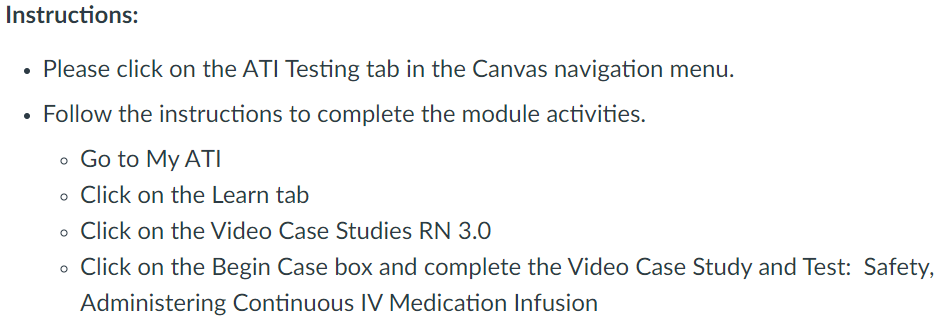
NUR105 M1.5: ATI Video Case Study
For anyone looking for assistance with NUR105 M1.5: ATI Video Case Study or preparing for the NCLEX Exam for nursing, I strongly encourage you to consider our services at FixMyGPA.com. We provide expert guidance and support to help you excel in your nursing education and exams. Don’t hesitate to reach out, and let’s work together to achieve your academic and professional goals. Visit our website today to take the first step towards your success.
A nurse is caring for a client who is receiving dextrose 5% water with 20 mEq of potassium chloride at 75 mL/hr. The provider has prescribed 1 g ceftriaxone IV. When preparing to administer this medication by intermittent IV bolus, which of the following actions should the nurse take first?
Answer: The nurse should first verify the medication’s compatibility with the primary IV solution to prevent the risk of precipitate formation in the IV tubing, which could harm the client.
A nurse is caring for a client who was admitted to the hospital for the same surgery and has a new prescription for continuous IV therapy. Which of the following actions should the nurse take when administering IV therapy NUR105 M1.5: ATI Video Case Study?
Answer: The nurse should inspect the IV solution for fluid color, clarity, and expiration date to ensure it is free of contaminants and safe for use.
A nurse is preparing to administer ceftriaxone 1 g in 100 mL IV over 30 minutes. The drip rate is 10 gtt/mL. The nurse should set the infusion rate to administer how many gtt/min?
Answer: The nurse should set the infusion rate to administer 33 gtt/min.
A nurse is assessing a client who is receiving 0.9% sodium chloride IV at 125 mL/hr. Which of the following should the nurse recognize as a possible complication related to the IV therapy?
Answer: The nurse should recognize that coughing and shortness of breath are possible signs of fluid overload. Slowing the IV and notifying the provider is necessary in this situation.
A nurse is caring for a client who is receiving 0.9% NaCl IV at 75 mL/hr through a triple lumen central venous access device. The IV pump alarm sounds, indicating that there is an occlusion. Which of the following actions should the nurse take first?NUR105 M1.5: ATI Video Case Study
Answer: The nurse should first check the line at or above the hub for kinked tubing that may be creating a resistance to flow.
A nurse is preparing to administer an IV medication to a client. The nurse should identify that which of the following is a disadvantage of administering IV medication?
Answer: The nurse should identify that IV medications are irreversible, meaning once administered, they cannot be retrieved. This can lead to serious consequences if there are issues with the medication.
A nurse is caring for a client who has a peripherally inserted central catheter (PICC) line. The nurse should identify that which of the following information is true about this type of IV route?
Answer: The nurse should identify that a PICC line is a long catheter inserted through the veins of the antecubital fossa, which is different from other IV routes.
A nurse administers the first dose of a client’s prescribed antibiotic via intermittent IV bolus. During the first 10 to 15 min of administration, which of the following assessments is the nurse’s priority?NUR105 M1.5: ATI Video Case Study
Answer: The nurse’s priority assessment during the first 10 to 15 minutes of administering an IV antibiotic via intermittent IV bolus is to assess the client for a systemic allergic reaction, as this poses the greatest risk.
For anyone looking for assistance with ATI testing or preparing for the NCLEX Exam for nursing, I strongly encourage you to consider our services at FixMyGPA.com. We provide expert guidance and support to help you excel in your nursing education and exams. Don’t hesitate to reach out, and let’s work together to achieve your academic and professional goals. Visit our website today to take the first step towards your success.


